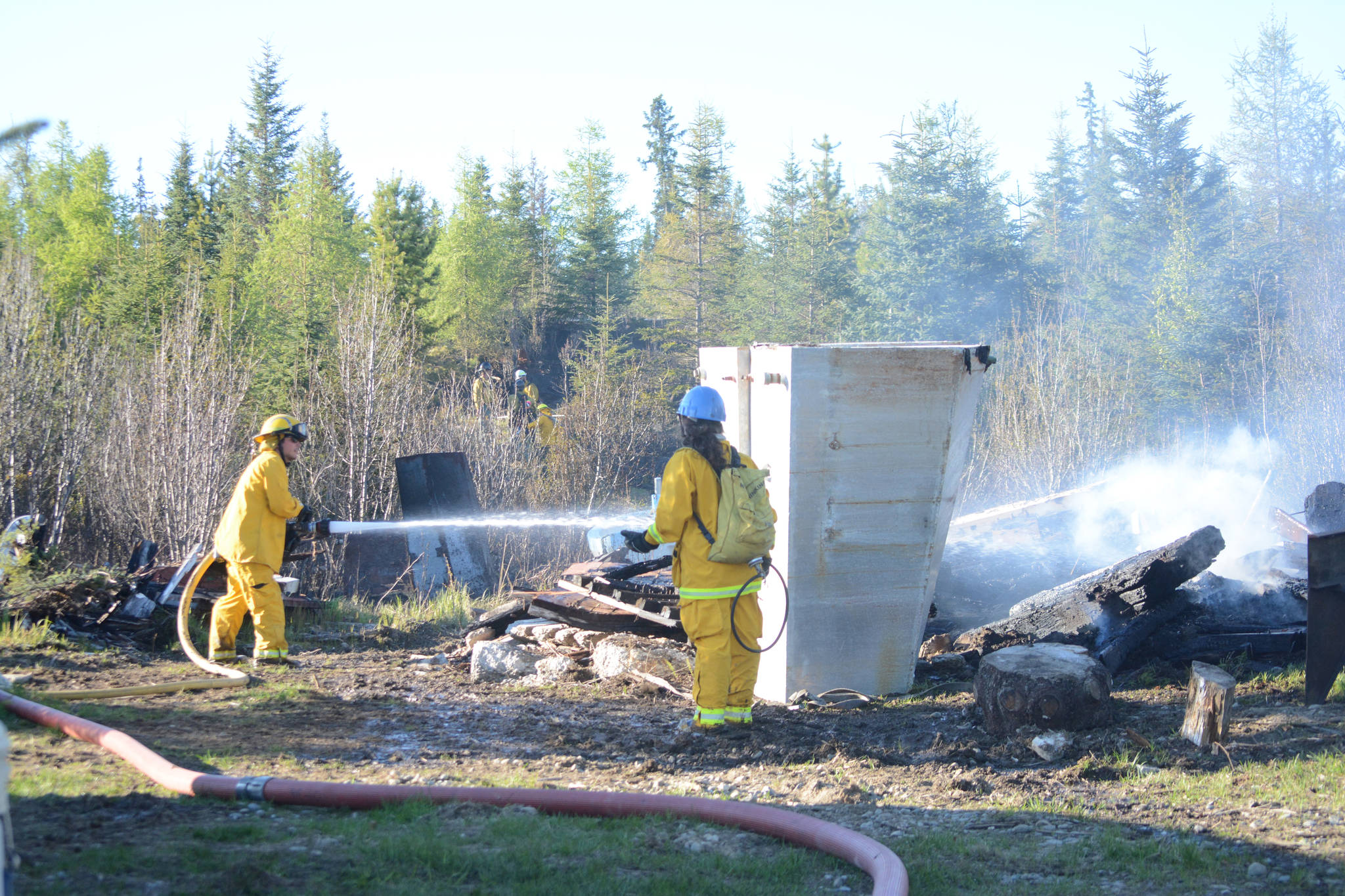An alert neighbor and a quick response from firefighters at about 6 p.m. Sunday saved two East End Road houses from being destroyed by a wind driven wildfire.
Kachemak Emergency Services, Alaska Division of Forestry, Homer Volunteer Fire Department and Anchor Point Emergency Services all went to the 2.1-acre fire in the woods behind four homes between Yukon Street and Greer Road on the north side of East End Road near Mile 9.
A resident of the area, Jack Allen, noticed black smoke, called 911 and began attacking flames with a garden hose. Allen happened to be outside detailing his truck when he noticed black smoke from a neighbor’s yard two lots to the west. He called 911 and Soldotna dispatchers paged out Kachemak Emergency Services and Alaska Division of Forestry to respond from Basargin Road, where they had just begun mopping up a 3.1-acre wildland fire on Basargin Road off Mile 19 East End Road that had started about 4:40 p.m.
“I’m glad I called in time to slow it down and get it there,” Allen said in a phone interview on Tuesday. “I’m sure it would have been a bad deal otherwise if I had been in my house or not in the yard.”
Allen said during the day he had noticed white smoke coming from a house at the Yukon Street end of the area. He’s lived in the area about 20 years and had been around in late April 2005 when the Tracy Avenue fire off Greer Road burned about 5,400 acres. The smoke got Allen’s attention when it turned to black.
“I know enough to know if you see brown and black it’s time to call,” he said.
Because firefighters were at the wildland fire near the gravel pit on Basargin Road, Allen said the dispatcher asked him to check to see if there were flames. KES got the page and had begun rolling equipment at 6 p.m, said KES Chief Bob Cicciarella on Tuesday.
Allen ran to the fire, saw flames and confirmed with dispatch there was a fire. Then his cell phone died. He ran to alert neighbors Bill Marshall and Karen Murdock of the fire in their yard. Allen said they told him they would be on the Spit so he used their phone to call — and then had to run to his house and plug in his cell phone to get Murdock’s cell phone number off his phone. He called her with a quick message: “Fire, get home.”
“After that I started figuring out what we needed for hose and putting out the fire the best I could until the real firemen showed,” Allen said.
Cicciarella said the fire spread out in fingers in alders and grass north of the homes. The fire burned down some sheds and outbuildings near Marshall and Murdock’s home and spread into the woods to the west and north of their home.
“I focused on getting a hose and tamp it back or something,” Allen said. “… It was charging toward the house.”
The fire came close to Marshall and Murdock’s home on the north side, but a mowed, green lawn to the west slowed down the fire. The path of the fire stopped dead at the lawn, an example of how what firefighters call Firewise — taking steps like clearing brush around homes to mitigate the spread of fire — can protect lives and property.
For more information on Firewise protection, visit the Alaska Division Forestry at http://forestry.alaska.gov/Assets/pdfs/home/firewise09.pdf.
A State Forestry helicopter with a water bucket responded from Basargin Road to East End Road and started making water drops. Cicciarella said a tanker plane out of Palmer with flame retardant had been sent to the Basargin Road fire but begun turning around when it was paged to the East End Road fire.
Allen said he kept hosing down his neighbors’ lawn and home.
“Finally a guy showed up with the Forestry department with a hose,” Allen said. “He started fighting the hottest spot which was directly back (behind Marshall and Murdock’s home). I was fighting the lower area. … One of the guys asked me if I wanted to let him take over. I relinquished the hose and took a rest.”
Except for the outbuildings and charred woods, the fire didn’t damage anything else. No one was injured, Cicciarella said.
“Two homes that were definitely threatened were saved and protected,” he said at the scene of the fire on Sunday.
A Yukon Type II initial attack crew from State Forestry worked the scene and stayed overnight to monitor the area for flare-ups. Five firefighters from that crew also responded to the Basargin Road fire. That fire started near a road to the gravel pit in willow, alder and grass, Cicciarella said.
Cicciarella said KES has “been running like crazy,” with almost half its calls fire responses, higher than usual. On Tuesday morning, firefighters went to a cabin fire on Eagleaerie Road that destroyed a dry cabin (see story, page 1). Medical and fire calls are up about 50 percent historically, with more fire calls than usual, Cicciarella said.
Vehicles from responding volunteer firefighters and other agencies slowed traffic near Mile 9 East End Road. Cicciarella said some people complained about the delay.
“All I can say is our priority is those houses that are being threatened,” he said. “If people are inconvenienced, all I ask is a little patience that people understand what we’re trying to do.”
Allen said he felt good about being able to help save his neighbors’ homes.
“I got to be the hero for the day,” Allen said. “…I was very fortunate to be that guy who happened to be at the right place and the right time. I’m glad I was there.”
KES investigators haven’t determined the cause of the East End Road fire, but Cicciarella said the Basargin Road fire may have been caused by humans. Both fires remain under investigation.
Reach Michael Armstrong at marmstrong@homernews.com.


